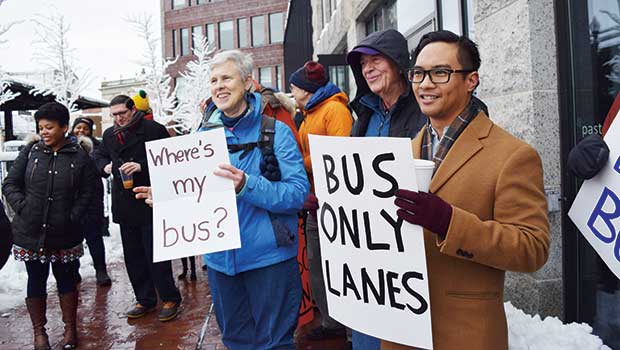Group seeks to prioritize MBTA bus transit
Members say low-cost solutions could alleviate traffic and improve service

The urban transportation advocacy group LiveableStreets Alliance has published a series of recommendations for city officials to improve the MBTA bus system’s reliability and accessibility, including dedicated bus lanes and transit signal priority technology.
In partnership with TransitCenter, a national urban mobility advocacy and research foundation, LiveableStreets released the independent report last Thursday, analyzing MBTA bus ridership and performance data and outlining specific recommendations that are “cost-effective and simple,” according to Stacy Thompson, executive director of LiveableStreets.
“They are things we can do tomorrow to make our streets more efficient,” Thompson said at a morning rally with elected officials and supporters March 8 in Dudley Square.

City Councilor Michelle Wu.
“This isn’t a big legislative agenda. We’re talking about paint on the ground, signal priority, things that we, as Bostonians, have control over,” she said.
With support from City Councilors Michelle Wu, Ayanna Pressley and Kim Janey, the campaign emphasizes the impact public transportation has on economic mobility, health and quality of life for Boston’s working class.
Wu, who is also chair of the city’s committee for planning, development and transportation, spoke at last week’s rally.
“Transportation is truly fundamental to economic mobility and equity. It is the number one factor correlated with someone’s ability to rise out of poverty,” she said. “Any step we can take to shave minutes off the bus ride, to better connect our transit systems and add infrastructure for cycling and walking, is a direct step we’re making to invest in the next generation’s stability and opportunity.”
As cited by the Better Buses: Getting Boston on Board report, the Metropolitan Area Planning Council’s 2017 State of Equity Report found that black riders spend 64 more hours per year on MBTA buses than white riders. And according to MassDOT data, 42 percent of bus riders are low-income and 48 percent are people of color.
As a sign of residents’ dwindling reliance on the bus system, the report cites an 8 percent decrease in overall bus ridership between 2015 and 2016 — the highest rate of decline across MBTA services.
“The City’s siloed approach to city-owned streets and state-managed transit service has resulted in service gaps that undercut the system and affect mobility for everyone in the region,” the report reads.
Solutions in sight
The policy recommendations include implementing bus-only lanes along high-ridership corridors; activating transit signal priority technology at choke points along corridors with high ridership and delays; upgrading bus stop amenities; creating new staffing positions that would carry out upgrades within the bus system and serve as an intermediary among the Boston Planning and Development Agency, the city’s Transportation and Public Works departments, the MBTA and MassDOT, and would be an extension of the Imagine Boston 2030 and Go Boston 2030 processes.
The report points to other nearby cities that have worked toward improving their bus routes.
The city of Everett implemented a bus-only lane on upper Broadway, and Cambridge has used transit signal priority at nearly a dozen intersections along Massachusetts Avenue and Prospect Street.
A dedicated bus lane piloted by the MBTA over the course of two days proved to be successful last December, shortening the commute along Washington Street from Roslindale Square to Forest Hills by four minutes. The MBTA plans to repeat the pilot in the spring on a daily schedule.
The Better Buses report also found that the fifth-most patronized route in Boston’s system comes in last for speed, relative to other Boston buses, and bus #66, the second-most used route, is slower than 99 percent of all MBTA bus routes.
LiveableStreets and TransitCenter identified key corridors with high ridership and consequent high delays and congestion where the policy recommendations, if implemented, would significantly improve the riders’ commutes.
These key corridors include Massachusetts Avenue between Storrow Drive and Albany Street; Washington Street between Warren Street and Melnea Cass Boulevard; the route between Ruggles Station and Dudley Street at Warren Street; between Forest Hills Station and Washington Street at Cummins Highway; and Brighton Avenue between Cambridge Street and Harvard Avenue.
Voicing support
“I am someone who is old enough to remember when we had an elevated train, coming from Dudley, that could get people in the black community and communities of color to where they needed to be at work, school or medical appointments,” said Councilor Janey at the rally. “Without that, we rely heavily on buses.”
Representative Russell Holmes and the Greater Grove Hall Main Streets organization has also publicly supported the Better Buses campaign and their policy recommendations.
Marc Ebuña, co-founder of TransitMatters, a Boston-based public transit advocacy group, told the Banner, “Long commutes create poverty traps, and the best way to get out of poverty and access jobs and economic mobility is better transportation, better mobility and transit.
“And it’s not affordable to own a car for many Bostonians,” he added.
Liveable Streets’ Thompson, addressing the rally last week, called for residents to take action.
“We need you to speak up and let everyone in Boston know there is a bus constituency and we do want to make change. We exist, the fixes are simple and we need you to speak up.”






